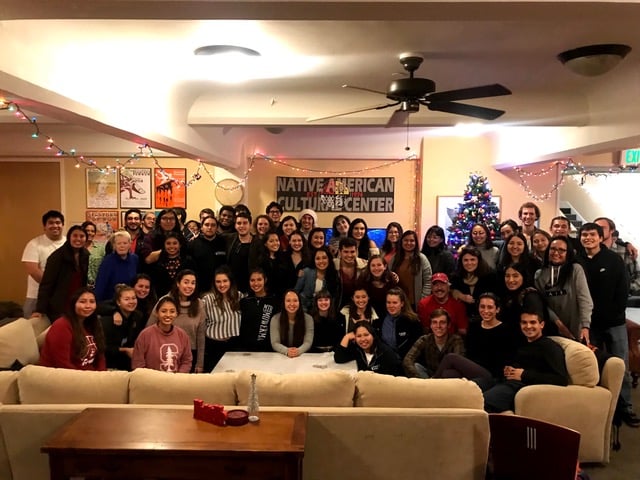Today, Oct. 21, marks the 50th anniversary of the Stanford American Indian Organization, an organization established to fill the representational vacuum of Native American students — undergraduate and graduate— on Stanford’s campus. The Stanford American Indian Organization currently serves as the umbrella organization for American Indians, Alaskan Natives, Native Hawaiians and Pacific Islanders. But at its foundation, represents a demographic of underserved and marginalized Indigenous students fighting for visibility, resources and physical space within the walls of a predominantly white institution, which to a handful who have passed through, is built on their ancestral homelands and actively displaced their ancestors.
As current SAIO co-chairs, reflecting on the 50 year legacy of Indigenous student-led activism, advocacy and community-building is an awe-inspiring evocation of tenacity as the founders of SAIO demanded spaces and resources curated for well-resourced white students be reoriented/redistributed to ease the academic and cultural transition into college for Indigenous students. The creation of SAIO is a key factor in how vibrant the Native community at Stanford is today, and we want to shed light on the historic events that have shaped SAIO over the past 50 years of existence.
In the five years prior to SAIO’s first convening in 1970, there was only one known Native American student to be enrolled at Stanford. By 1970, 25 more Native American students were enrolled. Although within a five-year span the demographic of Native students grew 25-fold, that number would not fill a Row house, whose normal occupancy is just under 40 residents, today. Furthermore, the sociopolitical occurrence to which SAIO and the enrollment of Native Americans at Stanford flourished, is strongly tied to urban Native activism, namely the Occupation of Alcatraz in 1969.
In North American Indigenous history, the Occupation of Alcatraz is a 19-month declaration against the settler-colonial forced removal of Indigenous populations from their homelands, broken treaties, continued systematic violence and active erasure by the U.S. government. With many of SAIO’s founders present throughout the Occupation, the frustration and demand for reclamation and repatriations continued, even when returning to Stanford’s campus. It was then, in 1970, when the Stanford American Indian Organization was formally established as well as when conversations around mascot removal began.
Removal of the “Stanford Indian” is an integral part of Stanford’s institutional memory which to us, Indigenous students, is an ode to the ways in which collective resistance and demonstration have championed change. The school’s angry caricature of an Indian remained intact until 1972. This means in 1965, the sole Native student enrolled was both out-represented and misrepresented by an “angry Indian” which, quite literally, brought Stanford large profits. However, in two years, it will be time to celebrate 50 years since the removal of the racist mascot and instead celebrate Stanford’s first Indigenous student to serve as the Tree, Dakota Brown (Miwok), who represented Stanford as LSJUMB’s unofficial mascot from 2018-2019.
In 1974, following the long overdue removal of the mascot, the early influence and labor of SAIO’s first leadership cohort continued to disrupt Stanford’s acceptance of Indigenous invisibility as the Native American Cultural Center, referred to as the NACC, was established. Followed by the NACC’s formation, which granted Indigenous students newly founded institutional leverage, programs specifically modeled for students continued to be enacted into the new millennium such as the Stanford Native Immersion Program and the Native-themed house officially named Muwekma-Tah-Ruk — “House of the People” in the Ohlone language — in 1988.
SAIO’s legacy of activism and community has continued across its 50 years of existence. Carson Smith ’19 and LJ Bird ’17 were a few of the key Native students and activists in the historic renaming process of both Serra House (now Sally Ride House) and Serra Mall (now Jane Stanford Way). Their perseverance through the multi-year process of renaming is said to have inspired the further addressing of Stanford’s past through renamings and Indigenous allyship.
“Before coming to Stanford University,” Zan, one of the co-chairs of SAIO ’20-21 writes, “I had never seen another Native scholar, even though I had attended three other community colleges. I think this is due to the fact that, similarly to Native Americans being 3% of Stanford’s student population, the native population had comprised <1% of the total student body. So when applying to schools, Stanford stood out even more because of the fact that they had a Native American Community Center (NACC) and I saw SAIO!”
“To me as a Native scholar at Stanford, SAIO has given me a community and home where I never had one. It taught me lessons I didn’t even know I was seeking. I had started transitioning from female to male before I had even heard of the term ‘two-spirit’ in a course at Stanford. I was able to hear Native Nobel laureates recite their poems; I saw Native artists be respected and have their work hung in contemporary art studios; I saw for the first time in my life Native Excellence. SAIO to me means giving natives a voice where there was an empty echo and an identity where there was just a stereotype,” Zan wrote.
In moments like these, of honoring and reflecting upon the history of such an incredibly impactful organization such as SAIO, one cannot help but imagine the achievements that may occur in the next 50 years of establishment.
In celebration of the date, SAIO is hosting the Indigenous ChangeMakers Panel tonight at 5 p.m. PDT to honor our community and its wondrous past, present and future. Register here if you are a Stanford Alum.
Contact Brentley Sandlin at bsandlin ‘at’ stanford.edu, Shayna Naranjo at shaynan ‘at’ stanford.edu or Zandreas Benitez at benitez7 ‘at’ stanford.edu on behalf of the Stanford American Indian Organization.
